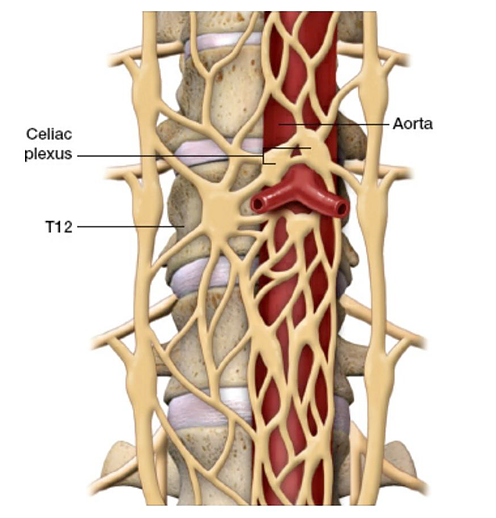What is a Celiac Plexus Block?
A celiac plexus block is an injection of drugs into a collection of nerves (called the ganglia ) in the lower thoracic area that sense pain around the pancreas. This can be due to pancreatic cancer or chronic pancreatitis. A celiac plexus block can relieve pain associated with pancreatic damage.
Why perform a Celiac Plexus Block?
A celiac plexus block is performed in order to get drugs, such as steroids and local anesthetic, as close to the nerve collection as possible. In a condition such as chronic pancreatic pain the nerves feel constant pancreatic damage and cause annoying pain in the upper abdominal area.
Performing this injection interrupts this constant sensation of pain and will allow you to perform certain activities and eat with less pain. This is a vital part of your recovery.
If you are taking a blood thinning medication you must let us know beforehand as this increases your risk tremendously. We will discuss your options and optimize the safety of this procedure.

Can anyone have a Celiac Plexus Block?
A celiac plexus block should be reserved for patients with cancer or pain that is not treated well by any other treatment. If you have any localized infection, such as a boil on your back, or a generalized infection, the procedure would not be performed until the infection has cleared up.
The procedure is done under X-ray to ensure that the injection is given in the correct place. If you are female and below the age of 55 you will be asked about the date of your last period, and if it is more than 28 days ago you, will be asked whether you are likely to be pregnant. Although the amount of radiation used is small, there is always a risk to the fetus. Occasionally we may need to ask you to have a pregnancy test.
The procedure cannot be done on anyone who has a problem with their blood clotting. Most commonly this is due to taking blood-thinning medication.
If you are taking a blood thinning medication you must let us know beforehand as this increases your risk of an adverse reaction tremendously. We will discuss your options and optimize the safety of this procedure.
What are the risks and complications?
Some common risks and complications that are associated with the celiac plexus block are diarrhea, dizziness, low blood pressure. It is possible to also damage the lung which is called a pneumothorax. If this should occur it can be an emergent issue that will require you to go to the hospital.
The positioning of the needle is next to the aorta which means it is very important to let her doctor know about blood thinners before having this performed.
Because the local anesthetic has an effect upon the nerves which supply the blood vessels in abdominal are, and makes them relax, there may be a fall in blood pressure which is associated with a feeling of faintness and nausea. This can be treated quite easily by giving fluid or drugs to reverse this effect. Infection is always a risk whenever anything is injected into the body, and we take precautions to avoid this by performing the procedure as a fully sterile technique. If an infection does get in it can produce the symptoms of feeling unwell, headache, and stiffness of the neck. This can occur quite soon after the injection.
How is the procedure performed?
The procedure is performed in the operating room or office under live X-ray. When you arrive a small needle may be inserted into one of your veins, for safety, so that should any drugs be required, they can be easily given. You will be expected to lie on the table on your stomach.
Local anesthetic is injected into the skin and deeper tissues to reduce the discomfort of the procedure. However, when the needle is inserted there will be a feeling of someone pushing in your back, which is normal. When the doctor has put the needle in, X-rays will be taken to confirm that the needle is correctly positioned. When the operator has confirmed that the needle is in the correct place, the injection will be given and the needle removed.
What happens after the procedure?
After the procedure you will go into the recovery area or return to the recovery area where your blood pressure will be monitored. As local anesthetic is normally used as part of the injection technique, you will notice some numbness or weakness of your legs. This is only a temporary problem, which will wear off.
What pain might you experience after the procedure?
The amount of pain experienced might become worse for a short period of time. If this occurs, it is not dangerous and should settle over time.
Back at home
You can remove the dressing from the injection site after 24 hours.
Will you be followed up afterwards?
You will be called for follow up to determine how the injection has helped you. This will usually happen within 2 weeks of your procedure.

